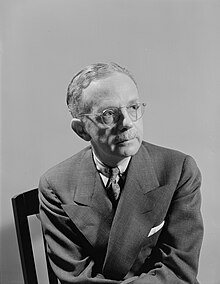Walter White (NAACP)

Walter Francis White (July 1, 1893, Atlanta, Georgia - March 21, 1955, New York, New York) was a spokesman for blacks in the United States for almost a quarter of a century and executive secretary (1931-1955) of the National Association for the Advancement of Colored People. After graduating from Atlanta University in 1916 (now Clark Atlanta University), in 1918 he joined the national staff of the NAACP in New York at the invitation of James Weldon Johnson. As Johnson's assistant national secretary and then as his successor at the helm of the NAACP, White waged a long and ultimately unsuccessful campaign for federal anti-lynching legislation in the United States House and Senate. White oversaw the plans and organizational structure of the fight against public segregation and was the virtual author of President Truman's presidential order desegregating the armed forces after the Second World War. He appeared white, a point he emphasized in his autobiography A Man Called White (p. 3): "I am a Negro. My skin is white, my eyes are blue, my hair is blond. The traits of my race are nowhere visible upon me."[1] Sinclair Lewis' novel, Kingsblood Royal, about a man who appears to be white but learns late in life that he is black is based in part on White's life. In fact, Lewis consulted White on the novel. [2]
During the Joseph McCarthy era of political repression and persecution, White did not wish to criticize McCarthy’s demagogic ways, believing that the inevitable backlash would cost the NAACP their tax-exempt status and lead to equating Civil Rights with Soviet Communism.[3] [4]
White was, in addition to his NAACP work, a journalist, novelist, and essayist. Through his cultural interests and his close friendships with white literary power brokers Carl Van Vechten and Alfred A. Knopf, White was one of the founding personalities of the "New Negro" cultural flowering, more popularly known as the "Harlem Renaissance." He married Gladys Powell in 1922, divorcing her in 1949. They had two children, Jane and Walter Carl Darrow White. White married a white magazine editor, Poppy Cannon, with whom he lived until his death in 1955. For twenty-five years he had been the most influential African American in public affairs.
Investigating the Elaine Race Riot
White faced Southern justice first-hand in October, 1919, when the NAACP sent him to investigate the violence known as the Elaine Race Riot in Phillips County, Arkansas. More than two hundred African American sharecroppers were killed by marauding white vigilantes and federal troops after a shootout in an attack on a church where the farmers were meeting left a white man dead.
White, who was of mixed race (five of his great-great-great-grandparents were black and the other 27 were white) and was blonde and blue-eyed and able to pass for white, was granted credentials from the Chicago Daily News. That enabled him to obtain an interview with Governor Charles Hillman Brough, who in turn gave him a letter of recommendation and his autographed photograph.
White was only in Phillips County for a brief time before his identity was discovered; he took the first train back to Little Rock. The conductor told him that he was leaving "just when the fun is going to start", because they had found out that there was a "damned yellow nigger passing for white and the boys are going to get him". Asked what they would do to him, the conductor told White that "when they get through with him he won't pass for white no more!"
White published his findings in the Daily News, the Chicago Defender and The Nation, as well as the NAACP's own magazine Crisis. Governor Brough asked the United States Postal Service to prohibit the mailing of the Chicago Defender and Crisis while others attempted to enjoin distribution of the Defender at the local level.
Author of Fire in the Flint (1924), Flight (1926), Rope and Faggot (1929), A Rising Wind (1945), A Man Called White (1948), and How Far the Promised Land (1955). White left unfinished "Blackjack," a novel on Harlem life and the career of an African American boxer.
External links
Further reading
- Cortner, Richard, A Mob Intent On Death, ISBN 0-8195-5161-9
- Kluger, Richard Simple Justice, ISBN 0-394-72255-8.
